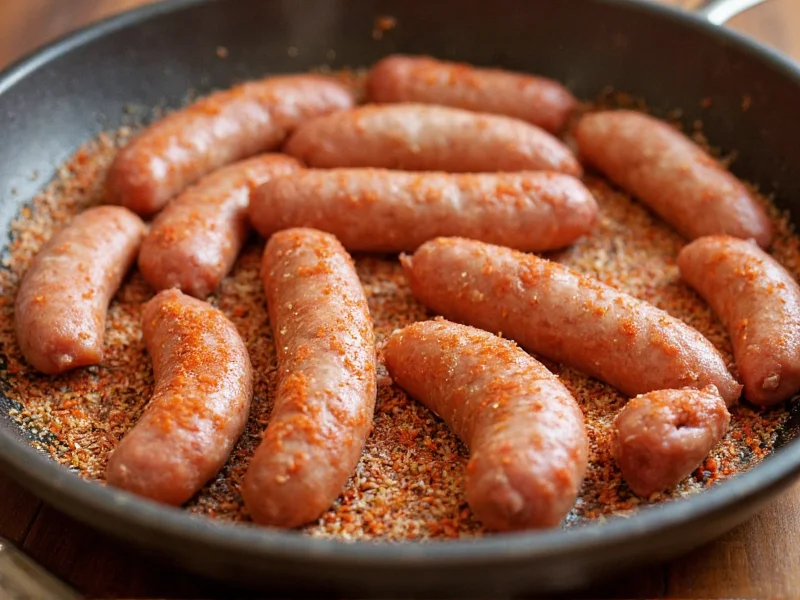Creating perfectly seasoned sausage requires understanding both culinary tradition and food science. While recipes vary by culture and meat type, the fundamental principles of sausage seasoning remain consistent across preparations. Proper seasoning affects not just flavor but also texture, preservation, and overall eating experience.
Core Components of Sausage Seasoning
Salt serves as the foundation of any sausage seasoning blend, performing multiple critical functions beyond flavor enhancement. At the proper concentration (typically 1.8-2.2% of total meat weight), salt extracts myosin proteins that create the emulsion binding fat and meat particles. This protein extraction is essential for achieving the characteristic sausage texture. Using less than 1.5% salt results in crumbly sausage, while exceeding 2.5% creates an unpleasantly salty product.
Curing salt (containing sodium nitrite) is essential for smoked or preserved sausages, preventing botulism and developing the distinctive pink color and cured flavor. For fresh sausages consumed within days, regular salt suffices. The precise measurement of curing agents is critical—typically 0.25% of total weight for safety and proper color development.
| Seasoning Component | Standard Proportion | Primary Function |
|---|---|---|
| Salt | 1.8-2.2% of meat weight | Protein extraction, preservation, flavor enhancement |
| Curing salt | 0.25% of meat weight | Botulism prevention, color development |
| Black pepper | 0.5-1.0% of meat weight | Flavor complexity, subtle heat |
| Garlic | 0.2-0.5% of meat weight | Aromatic enhancement |
| Sugar | 0.25-0.5% of meat weight | Balance acidity, aid browning |
Regional Seasoning Traditions
Understanding traditional sausage seasoning blends provides insight into flavor balancing techniques. German bratwurst typically features subtle notes of nutmeg and white pepper, while Italian sausage highlights fennel seed and red pepper flakes. Polish kielbasa relies on generous garlic and black pepper, and Spanish chorizo incorporates smoked paprika as its signature element.
These regional variations demonstrate how cultural preferences shape seasoning profiles while maintaining the fundamental salt-protein relationship necessary for proper texture. When adapting traditional recipes, maintain the critical salt percentage while adjusting secondary spices to taste preferences. This approach ensures both food safety and desired flavor characteristics.
The Science of Flavor Development
Seasoning effectiveness depends on proper incorporation techniques. Fat-soluble compounds in spices like paprika and garlic distribute best when mixed with the fat component before combining with lean meat. Water-soluble components such as salt and sugar require thorough mixing to ensure even distribution.
Temperature affects seasoning perception—chilled meat dulls flavor perception, which is why professional sausage makers recommend creating a small test patty. Fry this patty and taste it to adjust seasoning before committing to the entire batch. This technique prevents wasted ingredients and ensures proper flavor balance in the final product.
Avoiding Common Seasoning Mistakes
Many home sausage makers make critical errors that compromise their final product. Overlooking the importance of precise salt measurement ranks among the most frequent issues. Using table salt instead of kosher salt without adjusting for density differences leads to inconsistent results.
Another common mistake involves adding liquid ingredients like wine or vinegar without adjusting other liquid components. These additions dilute seasoning concentrations and can affect the critical protein extraction process. When incorporating wet ingredients, reduce other liquids proportionally to maintain the proper seasoning concentration.
Practical Seasoning Adjustments
Seasoning preferences vary by individual and cultural background. When developing custom blends, start with established proportions then adjust incrementally. Increase black pepper by 0.1% increments rather than doubling the amount. Remember that flavors meld and intensify during the resting period—allow seasoned meat to rest refrigerated for 12-24 hours before stuffing for optimal flavor development.
For those experimenting with alternative meats like game or poultry, adjust seasoning proportions accordingly. Leaner meats require slightly less salt (closer to 1.8%) while fattier cuts can handle up to 2.2%. Poultry sausages often benefit from additional aromatic elements like sage or thyme to complement the milder meat flavor.
Frequently Asked Questions
How much salt should I use in homemade sausage?
Use 1.8-2.2% salt by total meat weight for optimal results. For example, 18-22 grams of salt per kilogram of meat. This range ensures proper protein extraction for binding while providing adequate preservation and flavor. Measure precisely using a kitchen scale rather than volume measurements for consistent results.
Can I substitute curing salt with regular salt in sausage recipes?
For fresh sausages consumed within 2-3 days, regular salt suffices. However, for smoked, dried, or preserved sausages, curing salt (containing sodium nitrite) is essential for preventing botulism. Never substitute regular salt for curing salt in recipes requiring preservation, as this creates serious food safety risks. Curing salt should comprise approximately 0.25% of total meat weight.
Why does my sausage seasoning taste weak after cooking?
Seasoning perception decreases when meat is cold, so many home sausage makers under-season. Always create and cook a small test patty before stuffing the entire batch. Additionally, flavors mellow during cooking, so seasonings should be slightly stronger in the raw mixture than desired in the final product. Allow seasoned meat to rest refrigerated for 12-24 hours before cooking to let flavors fully develop.
What's the best way to incorporate dry seasonings into sausage meat?
For even distribution, mix dry seasonings with a small amount of the meat's fat content first to create a paste, then gradually incorporate into the remaining meat. This technique ensures spices distribute evenly rather than clumping. Mix at temperatures below 40°F (4°C) to prevent fat smearing, and avoid over-mixing which can damage protein structure. Proper mixing typically takes 2-3 minutes with a stand mixer on medium speed.











 浙公网安备
33010002000092号
浙公网安备
33010002000092号 浙B2-20120091-4
浙B2-20120091-4